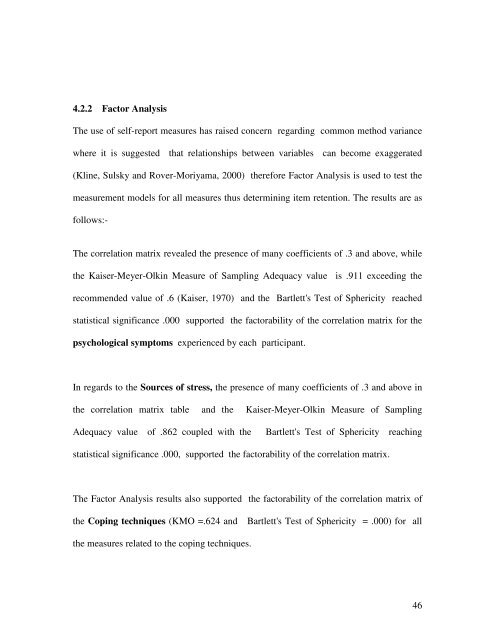1 CHAPTER 1 INTRODUCTION 1.0 Overview Over ... - DSpace@UM
1 CHAPTER 1 INTRODUCTION 1.0 Overview Over ... - DSpace@UM
1 CHAPTER 1 INTRODUCTION 1.0 Overview Over ... - DSpace@UM
Create successful ePaper yourself
Turn your PDF publications into a flip-book with our unique Google optimized e-Paper software.
4.2.2 Factor AnalysisThe use of self-report measures has raised concern regarding common method variancewhere it is suggested that relationships between variables can become exaggerated(Kline, Sulsky and Rover-Moriyama, 2000) therefore Factor Analysis is used to test themeasurement models for all measures thus determining item retention. The results are asfollows:-The correlation matrix revealed the presence of many coefficients of .3 and above, whilethe Kaiser-Meyer-Olkin Measure of Sampling Adequacy value is .911 exceeding therecommended value of .6 (Kaiser, 1970) and the Bartlett's Test of Sphericity reachedstatistical significance .000 supported the factorability of the correlation matrix for thepsychological symptoms experienced by each participant.In regards to the Sources of stress, the presence of many coefficients of .3 and above inthe correlation matrix table and the Kaiser-Meyer-Olkin Measure of SamplingAdequacy value of .862 coupled with theBartlett's Test of Sphericity reachingstatistical significance .000, supported the factorability of the correlation matrix.The Factor Analysis results also supported the factorability of the correlation matrix ofthe Coping techniques (KMO =.624 andBartlett's Test of Sphericity = .000) for allthe measures related to the coping techniques.46
















